9. SPECIALIST HITSHow to describe the sabotage of other 'non-standard' systems is more difficult. You should be able to figure out what to do by using the energy flow analysis of the system, and copying some of the ideas applied to the standard systems described in the sections above. In practice you may end up treating a complex machine - for example a roadstone coating plant, as a collection of discrete systems rather then as one entity. Construction hoists (figure 27)
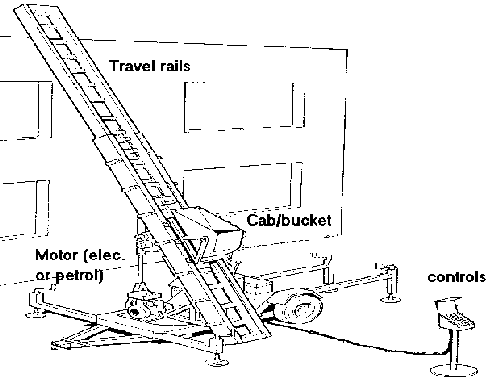 9.1 Construction equipmentMost construction equipment can be tackled with the information already given in this Volume, and Volume I. But on construction sites you often find hybrid machines - for example the hoist illustrated on the following page. A key consideration of hitting something like a construction site is not only to consider the machines as systems - with energy and material flows - but also you should look at the whole site as a functioning entity. Material stockpiles are needed to make the whole thing function. Likewise, machines such as cement mixers can be as important as earth movers. Tower cranes (figure 28)
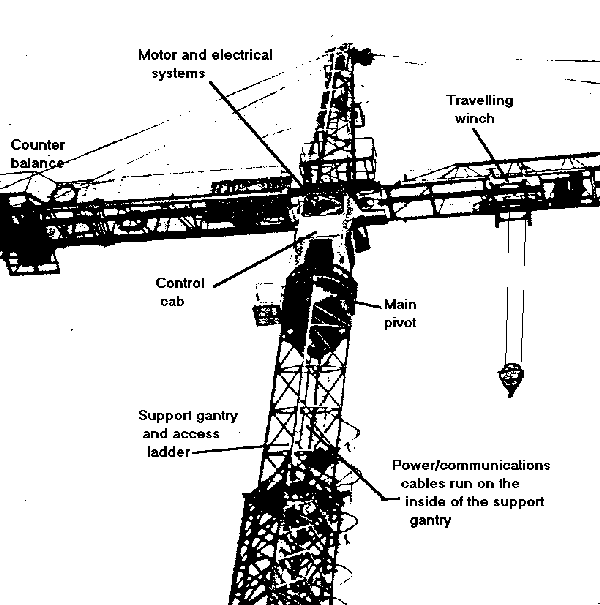 There are a number of things you can do on construction sites...
9.2 Quarry equipmentQuarrying is probably one of the most damaging landuses in lowland meadows, and in hilly/mountainous areas. It is not only because of the effect of quarrying on habitats, but also the effect on water tables, and the land uses that follow such as waste disposal or watersports. There are four key targets in the quarry works... The only thing to beware of with quarries is making sure that you don't get trapped. Especially in deep quarries, if your exit is blocked, or if you fall into a pit with no escape, you only option is to wait for the owners to find you. 9.3 Farm machinery There are a wide variety of farms. Some have only arable planting/harvesting equipment. Some concentrate on dairy products. Some intensively farm just one type of animal. In general, it is the intensive farms which present the greatest offence to the environment. Not only is there the issue of animal welfare, but intensive farms can also present a serious pollution hazard to the soil, to nearby watercourses, and often create local noise and smell nuisances. When you take action against a farm, you must consider, first and foremost, what you attitude to the animals is. You actions may have implications for the welfare of animals - it may even cause their deaths. You must decide if you wish to uphold their right to life, or whether you believe that a short period of discomfort will effectively 'end' their misery. Hoppers and materials storage (figure 29)
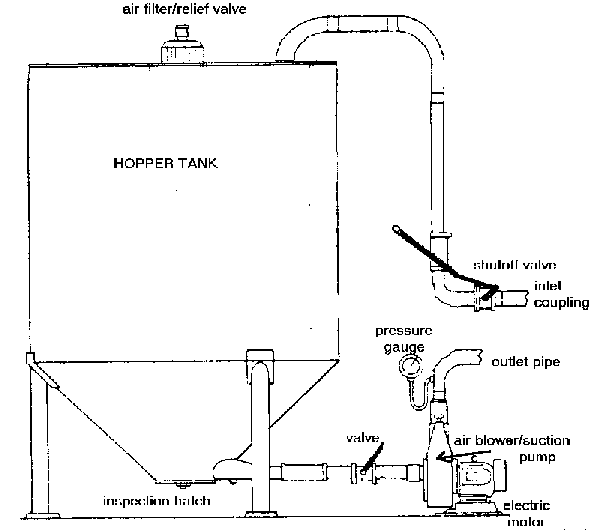 There are a number of targets which you should consider sabotaging... A word of caution though. Many farms have 'live-in' staff, and so security can be a problem. Another recent innovation are 'trip wires' and 'pressure pads' - these are linked to flares or squibs and are meant to announce the presence of intruders. Although not all farms have them, they are becoming increasingly popular to prevent uninvited guests, thieves, or animal rights protesters. They are very difficult to spot in the dark, and if you have just spent twenty minutes quietly stalking up to a barn and you set a thunderflash off it can scare the hit out of you. Mains electrical systems (figure 30)
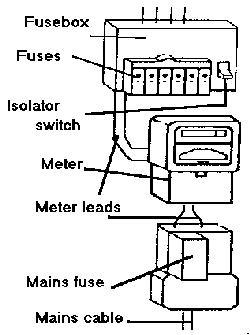 9.4 Pipelines and transmission linesPipelines and electricity transmission lines are extremely easy targets to take on, but can be immensely dangerous. If you are considering such things as high-pressure gas pipelines, or any electric cable carrying more than 415 volts, my tip to you is to forget it!! There are easier ways to die. But there are some targets you can consider... Mains voltage power lines (that is, less than 500 volts) are difficult to cut - even with the standard household 240 volts you could conceivable kill yourself. In these situations you should consider 'burning' through the cable - the simplest way to do this is to place a blow lamp on the cable or pipe, and then retire to a safe distance very quickly. You might risk 'chopping' them with an axe, but if you cause a serious short the spatter of molten metal could cause burns. Low voltage power lines (less than 50 volts) can be easily cut with cutters, provided that they have insulated handles, or you wear thick rubber gloves. Again, beware things like high current induction motors or welding equipment - these carry large amounts of current which could arc and burn you. Pumps are an easy target. You can either go for the motor driving the pump, or you can go for the pipeline. There are two types of pump... · Diaphragm pumps operate using an oscillating membrane and two one-way valves. They can often be identified by the regular pulsing and gushing of water along the pipes. If you can introduce some long hard objects, such as pieces of stick or wood, these can block the valves of the pump. Otherwise you should go for the engine/motor driving the pump. · Rotary pumps have a disk rotating at high speeds (the 'impeller') which continuously sucks/pushes water - so you don't get the same pulsing. The lack of vales makes them difficult to sabotage, so you should go for the engine/motor driving the pump. With both types of pump, they operate by generating a 'low' pressure on the sucking side, and creating a 'high' pressure on the blowing site. If you puncture the pipes on the low pressure side you let air in and the pipeline loses suction. Likewise if you puncture the high pressure side the pipeline leaks. Diaphragm and rotary pumps (figures 31/32)
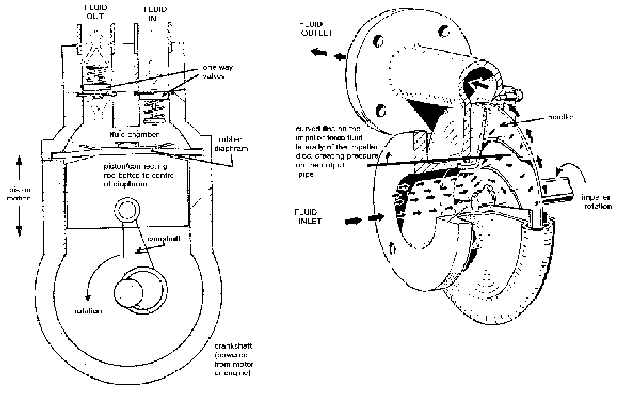 Coaxial cables (figure 33)
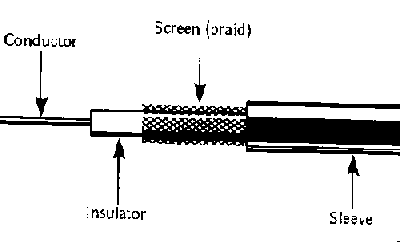 Coaxial cables carry radio waves, and are used on transmitter masts, computer networks, and some radio intercom systems. They can be easily cut with side cutters, or better still stapled with a staple gun (this shorts the cable and potentially could wreck the transmitter). Beware microwave transmitters - sometime these use (waveguides) just behind the dish which can be dangerous to your health if cut. It is possible to cut high pressure pipes or high voltage cables using some sort of chemical incendiary mixture, but this is still very risky. You also have the problem that the chemical incendiaries could burn away without breaking the pipe/cable, but causing serious damage which may endanger someone. Also the chemical incendiary could start a fire in the area, ignite the contents of the pipeline, or if the pipeline holds high pressure the explosive breach could throw burning incendiary incendiary over a large area and start fires. 9.5 Commercial premisesCommercial premises present a challenge to the saboteur - but many rewards. As security technology increase, even the most innocent site office can have as much anti-intruder protection as you local bank. This is because what is inside offices - computers, fax machines, and increasingly data - is becoming more valuable and needs protecting. Getting past security systems cannot be taught here - there is not enough room, and you must learn some highly technical electronic and computer skills. Sometimes it may be worth organising your hit to take place within 30 seconds to one minute, and then just smashing your way in triggering every security device on the premises. If you can guarantee that security personnel will not arrive for five or six minutes, then you can make a getaway. There are also a number of targets you must consider. As noted at the beginning of this section, you can treat something 'new' as a set of systems, using the analysis described earlier in this volume. But commercial premises present some very specific pieces of equipment which you might like to know more about. Forklifts (figure 34)
 In many commercial/industrial premises, you will find some sort of forklift truck for loading/unloading vehicles, or working within stores/high bay warehouses. Forklifts are either electrically powered using a battery pack, or they run on a gas engine, powered by a bottle of compressed gas mounted on the back of the machine. The illustration on the following page shows a typical forklift. The control panel is simple, and easily accessible. But getting at the electric motors and gearing mechanisms can be difficult. Although many forklifts use cable or chains for lifting, some use hydraulic system - in these cases the usual 'hydraulic' systems rules apply. Beware electric fork lifts - if you short the battery pack you might have a small explosion because of the power the pack can generate. On most battery fork lifts the pack has a connector which pulls out of a socket and plugs into a battery charger. You have the choice of either turning the charger off, disconnecting the battery and sabbing the charger box, or disconnecting the pack from the socket it plugs into on the truck, and smashing this socket. Do not smash the plug connected to the battery pack because this could cause a short. Refrigeration systems (figure 35)
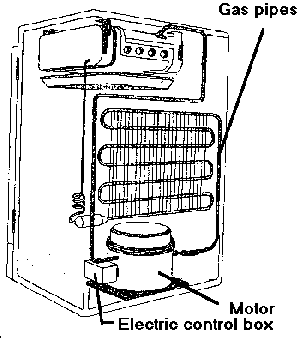 Another common thing to find in commercial premises is refrigeration systems - used as either actual cold stores/fridges, or used as cooling systems/air conditioning units. If you damage the refrigeration system it can be a very expensive job not only replacing the system, but also the goods which may go off when they warm up. The illustration on the previous page shows a traditional 'domestic' style fridge, but commercial units operate in roughly the same way - they just have the parts arranged differently. You must take care when taking on these systems because they contain flammable gases such as butane, highly irritating gases such as ammonia, or asphyxiating gases such as halon (CFCs). If you cut the pipes and release these gases, you will have to evacuate immediately. In practice it is safer to take on the electrical control systems and put them permanently out of action. Modern refrigeration systems use electric motors which drive specially designed pump or screw compressors. By disabling the motor, or is power source, you disable the cooling system. The problem comes where the motor and pump form one sealed unit - in these instances you can only disable the power source. Another thing to consider, especially where machinery is involved, is the effect that damaging the gearing and bearing systems will have. The illustrations on the following pages show different types of gear and bearing that you may see on industrial machinery. Gearing and bearing systems (figures 36/37)
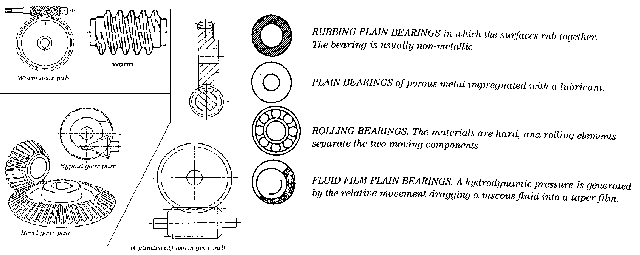 Gears are most easily damaged by breaking or denting the 'teeth' on the cogs that make up the gear. Cast gears can be broken with a lump hammer. Prising open smaller gear sets with a crowbar will have an equally deleterious effect. Some gear systems are oil lubricated, or contained within some sort of sump - in these cases just put sand in the sump to act as an abrasive. 'Worm' gears are particularly susceptible to having things jammed in them - if you use some mild steel roads (for example short nails) these work their way into the gears causing a jam. Bearings are harder to damage, mainly because they are encased inside the machine. But there they are visible you can damage them using a hammer and cold chisel/centre punch, or by jamming steel nails into the bearing. If a bearing is lubricated with grease, try mixing 2 parts (by volume) of grinding/polishing powder to 3 parts lubricating grease, and then apply this to the bearing. If this goes unnoticed the bearings will slowly wear and begin to rattle in their races. 9.6 High security compoundsEntering high security compounds - such as those surrounding military bases, nuclear establishments or sensitive commercial premises - is a bit like putting you head in a lions mouth. You have to hope that is doesn't bite. As noted with commercial premises, you could just rush the place head on, do your work within a minute, and then get away quickly. Sometimes that may be your only option, but there are alternatives. A tactic within the anti-nuclear movement was to treat the high security compound itself as the target. Thus you regularly set alarms off, cut holes in fences, or throw stones at security cameras. If this gets a regular occurrence, to the point where the staff don't immediately react, this may provide a 'time window' where you can actually get in and do some real work. 9.7 Marine targetsMarine target fall into roughly two types - things that float, and things that are fixed to the ground but have water around them. Floating things can be sunk - but this presents risks of pollution and danger to people on the floating object. Things that are fixed to the bottom are generally on interest because of what is on them. Never sink anything while people are aboard it. If you want to sink something what you have to consider is how long the thing will take to sink - this is important as it means that you can guarantee that the object will sink within a certain amount of time. First you estimate the internal volume the object - call this V, and measure it in cubic metres. If we assume that you are going to drill the hull of the object, then find the diameter of you drill bit - call this D and measure it in millimetres. Finally, work out how far below the waterline you are going to drill the hole(s) - call this H and measure it in metres. Finally, decide how many minutes you want the object to sink in, and call this M. The number of hole you will have to drill to sink the object in the required time is then calculated using the formula... T = V / ( 0.009426 * D2 * H * M )To simplify matters, the table on the following page gives the time for an object to sink (right axis, in minutes) for a given volume (bottom axis) and a drill size (top line is 5mm, next 10mm, 20mm, 30mm, bottom line 50mm). These calculations assume that 10 holes are drilled. For every extra 10 holes drilled, halve the time. Taking on fixed targets depends a lot on their nature. Docks and quays present the obvious advantage that things can be easily disposed of - into the water. Also, where you have a secure compound, access from the water can get around many problems such as fences and guard. But beware - some sites, such as military installations, have nets and alarms to stop swimmers/divers, and on occasions the security troops have used special stun grenades to disable swimmers attempting to access protected docksides. Sink times (table 0)
 In terms of everyday hits, waterborne access can add a new dimension to the planning of hits. For example, if you ever get cornered and there is a river next to the site, you can jump in, drop you tools to the bottom, and then float away downstream. Likewise there are many sites - for example chemicals installations, that are built on waterways, and have minimal security along their water side because the water is assumed to be a barrier in itself. One obvious safety point in relation to waterborne hits - it does help if you can swim. Likewise, if you are taking a boat out on the open water, make sure that you are skilled to handle it.
[Back to Contents]
[Go to next section]mailto:webmistress@sabotage.org goto:webmistress |